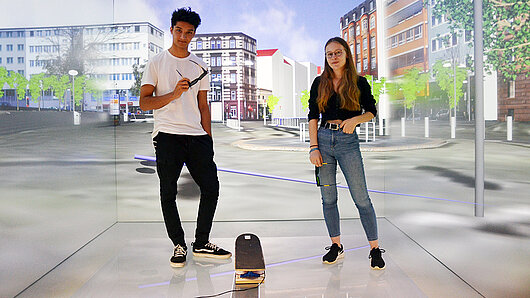High-Performance Computing Center Stuttgart

As a center within the University of Stuttgart, HLRS accepts students interested in undertaking research projects as part of their academic studies. Here you can find an incomplete list of topics suitable for bachelor and master theses, as well as topics for general semester works (Studienarbeit).
If you are a student, please don't hesitate to contact us if you have your own ideas as long as they have to do with scientific visualization, interactive simulation, VR, AR, driving simulation, sensor simulation or machine learning.
There are no real prerequisites but keep in mind that you need to account for some extra time if you need to learn a new programming language during your thesis.
All theses can be written in either German or English, so don't be afraid if the description here is in English.
Today's GPUs provide ample resources for per pixel-based lighting computation. They can be used to represent material properties in more physically correct way. The goal is to implement a set of GLSL shaders representing the material properties described in glTF. The shaders will be used in OpenCOVER and required state attributes such as Uniforms and vertex attributes have to be implemented in OpenSceneGraph.
Programing languages: GLSL, C++
A renaturation project in the Bottwar valley is including grazing by water buffalos.
In order to study the effect the water buffalos have on both fauna and flora are studied during a multi year research project. The HLRS is surveying the area regularly with a drone and provides a webpage to browse imagery and other data collected at the cite, see https://wasserbueffel.hlrs.de. The page is implemented using OpenLayers. The goal is to extend this website with an editor which allows to map the avifauna on site
Programming languages: Javascript, Node.js
Our OpenDRIVE road editor needs to be extended by a flexible road sign editor.
This includes arranging multiple traffic signs on a single pole as well as a text editor for street signs.
The OpenBikeSensor is a device mounted on bicycles to measure the overtaking distance of motor vehicles. Ultrasonic sensors controlled by a microcontroller are used for this purpose. Until now, overtaking events had to be manually confirmed by pressing a button. The goal of this project is the automated detection of events using a neural network implemented directly on the microcontroller. The individual steps include:
Development of a smartphone app for recording and storing measurement data from external sensors. The OpenBikeSensor Lite is a device mounted on bicycles to measure the overtaking distance of motor vehicles. Data is sent via the serial interface as a protocol buffer. These data need to be recorded and combined with internal data sources (e.g., GPS coordinates, time). After the ride, the datasets should be transferred to a data portal. Depending on the scope of the project and prior knowledge, enhancements such as Bluetooth communication and cross-platform development for Android and iOS are possible.
In our collaborative VR applications, partners should be represented by human avatars. The project will investigate whether realistic human poses for avatars can be calculated from the already captured transformations of one hand and the head.
Programming Language: C++
APIs: OpenSceneGraph/OpenGL/Cal3D
Older people are often prone to fall and then require immediate help but current emergency calls are often cumbersome to use, lead to many false alarms and only cover parts of a flat. We intend to develop algorithms to automatically detect persons in need of assistance. The hardware targeted will be NVIDIA Jetson Nano or AGX Xavier modules with cameras, microphones and speakers. This thesis will focus on all aspects of Machine learning from labeling of real world data to training and execution of neural networks as well as reliable communication with the users of the system.
In numerical simulation, adjusting simulation parameters is a central process but often cumbersome and time-consuming when using traditional input methods such as a mouse and keyboard. Virtual Reality (VR) offers the potential for interactive and immersive approaches to real-time parameter adjustment, improving efficiency and user experience. By directly monitoring simulations in VR, simulation behaviors can be analyzed, and parameters such as boundary conditions or grid resolutions can be dynamically adjusted without interrupting the computational process. This significantly reduces I/O operations and allows immediate responses to simulation results.
The interactors can be implemented in our in-house visualization tool Vistle and our VR renderer OpenCOVER.
Programming Language: C++
APIs: OpenSceneGraph, Catalyst II, Vistle, OpenCOVER
Arbeit 1:
Entwicklung eines GLSL Shaders zur Visualisierung von Autoscheinwerfern
Wünschenswert: C/C++, OpenGL Kenntnisse
Arbeit 2:
Entwicklung von GLSL Shadern zur Visualisierung von Fahrbahneffekten
Wünschenswert: C/C++, OpenGL Kenntnisse
Arbeit 3:
Erweiterung eines bestehenden Echtzeit-Fahrdynamikmodells für den HLRS-Fahrsimulator in virtueller Realität
Wünschenswert: C/C++
Arbeit 4:
Interaktive Simulation der Klimatisierung von Rechenräumen
Voraussetzung: C/C++
Arbeit 5:
Messung und Analyse der Latenz- und Reaktionszeiten einer Fahrdynamiksimulation am HLRS-Fahrsimulator in virtueller Realität
Voraussetzungen: C/C++, Grundverständnis der Fahrdynamiksimulation
Arbeit 6:
Aufbereitung und Verarbeitung räumlicher Punktwolken aus Laserscans für die virtuelle Realität
Voraussetzungen: C/C++, fundierte mathematische Kenntnisse zur Verarbeitung räumlicher Daten
Arbeit 7:
Entwicklung eines VISTLE Lesemoduls für StarCCM+ Daten
Voraussetzung: C/C++
Arbeit 8:
Automatische Kamerakalibrierung unter Berücksichtigung variabler Brennweite (Zoom oder Wechseloptiken)
Voraussetzung: C/C++, OpenCV
Arbeit 9:
Markerloses “Inside-Out”-Kameratracking für die rechnerunterstützte forensische Photogrammetrie und 3D-Rekonstruktion
Voraussetzung: C/C++, OpenCV
Arbeit 10:
Visualisierung von Strömungssimulationen der Daimler AG mit Hilfe des parallelen Visualisierungssystems VISTLE, Entwicklung geeigneter Lesemodule
Voraussetzuung: C/C++
Arbeit 11:
Simulation der Schiffsbewegung bei Wellengang und Wind zur Simulation des autonomen Landens von Hubschraubern auf Schiffen mit Hilfe von OpenFOAM
Wünschenswert: C/C++, numerische Simulation
Arbeit 12:
Entwicklung und Implementierung eines Tischscanners für automatisiertes 3D-Scannen kleiner Objekte
Wünschenswert: C/C++, OpenCV